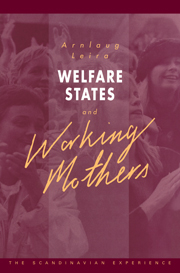Book contents
- Frontmatter
- Contents
- List of figures
- List of tables
- Preface and acknowledgements
- List of abbreviations
- 1 Introduction
- 2 Models of motherhood
- 3 Welfare states and working mothers: the Scandinavian experience
- 4 The collectivization of childcare
- 5 Mothers, markets and the state
- 6 Modes of mothering
- 7 Carer state and carer careers
- Notes
- References
- Index
7 - Carer state and carer careers
Published online by Cambridge University Press: 05 December 2011
- Frontmatter
- Contents
- List of figures
- List of tables
- Preface and acknowledgements
- List of abbreviations
- 1 Introduction
- 2 Models of motherhood
- 3 Welfare states and working mothers: the Scandinavian experience
- 4 The collectivization of childcare
- 5 Mothers, markets and the state
- 6 Modes of mothering
- 7 Carer state and carer careers
- Notes
- References
- Index
Summary
Introduction
The making of motherhood in the post-World War II period in Scandinavia is profoundly influenced by the interplay of two processes: one is at work in the restructuring of boundaries between the state and the family in childcare, the other is demonstrated as a shift in the gendered division of labour within families, and notably in the increased economic activity of mothers.
In the Scandinavian countries this motherhood experiment is supported by the welfare state. However, as I have shown, welfare state policies alone do not account for the reconstruction of motherhood registered in the years 1945–85. Motherhood is also changed by other actors, and most importantly by mothers themselves. My examination traces changes in the material basis of motherhood and in the opportunity situation of mothers. I consider welfare state approaches and mothers' responses to motherhood. Including the recent political history of motherhood as well as mothers' everyday practices in the analysis does not imply that I see ‘mothers’ and ‘welfare state’ as actors of equal stature, power and authority. What I do emphasize is that everyday action is an important element in producing structural change.
My analysis focuses on two aspects of motherhood, what I have termed the ‘earner’ aspect, referring to economic activities, and the ‘carer’ aspect, which encompasses nurturing, rearing and upbringing. Social theory usually casts mother as the parent primarily responsible for childcare, and primarily as a carer-parent. Dealing with Scandinavian mothers as my main case, I do not take issue with the first part of the argument.
- Type
- Chapter
- Information
- Welfare States and Working MothersThe Scandinavian Experience, pp. 161 - 177Publisher: Cambridge University PressPrint publication year: 1992



